
Paper
Chin, W. C. B. (2018) The scaling properties of point clustering phenomena. Department of Geography, National Taiwan University. Dean's Award (Ph.D.), College of Science, National Taiwan University.
Abstract
Conventional spatial statistics analysis reveal either the global or local spatial pattern for point distribution but ignore the big picture of the point data, which can be observed through a scaling process. As discussed in spatial statistical studies, point distribution may show a scale-dependent spatial pattern, which situation is known as the modifiable areal unit problem (MAUP). On the other hand, as suggested in fractal analysis studies, the point pattern change at a consistent rate at the beginning of the scaling process, and the rate decrease after a scale. This scale of rate shifting (namely critical scale, CS) is the finest scale that can capture the big picture of the point distribution (namely macro pattern), i.e. the changes of pattern due to MAUP have the same effect since the global level, and the higher scales after CS will only affect the pattern of partial area. In this study, a scaling analysis framework was proposed to identify the critical scale, and a set of aggregation procedure was designed to convert the original point dataset into the macro pattern. Three experiments were conducted to test the scaling analysis framework, including two experiments on theoretical distributions and one on empirical point distributions. The three experiments were designed: (1) to test the aggregation effect on scaling process; (2) to test the influences of mono-centric clustering properties to the scaling analysis; and (3) to illustrates the contrast between macro patterns and the original distribution of empirical data. The results suggested that the aggregation point on critical scale could capture most of the spatial properties from original data; the area and number of point formed a logarithm relationship with the critical and final scale; and the big picture of the point distribution could be captured by the macro pattern of the aggregated points on critical scale. Aside from the conventional understanding of point pattern as discussed in the previous global or local spatial statistics methods, this study provides not only a new tool but also a novel perspective of viewing the point distribution. This analysis framework, including the critical scale identification and macro pattern aggregation, can be useful for spatial point data exploration and map visualization.
Read article here:
- Official website: The scaling properties of point clustering phenomena, National Taiwan University Dissertation,
- Please contact me (by Gmail ).
